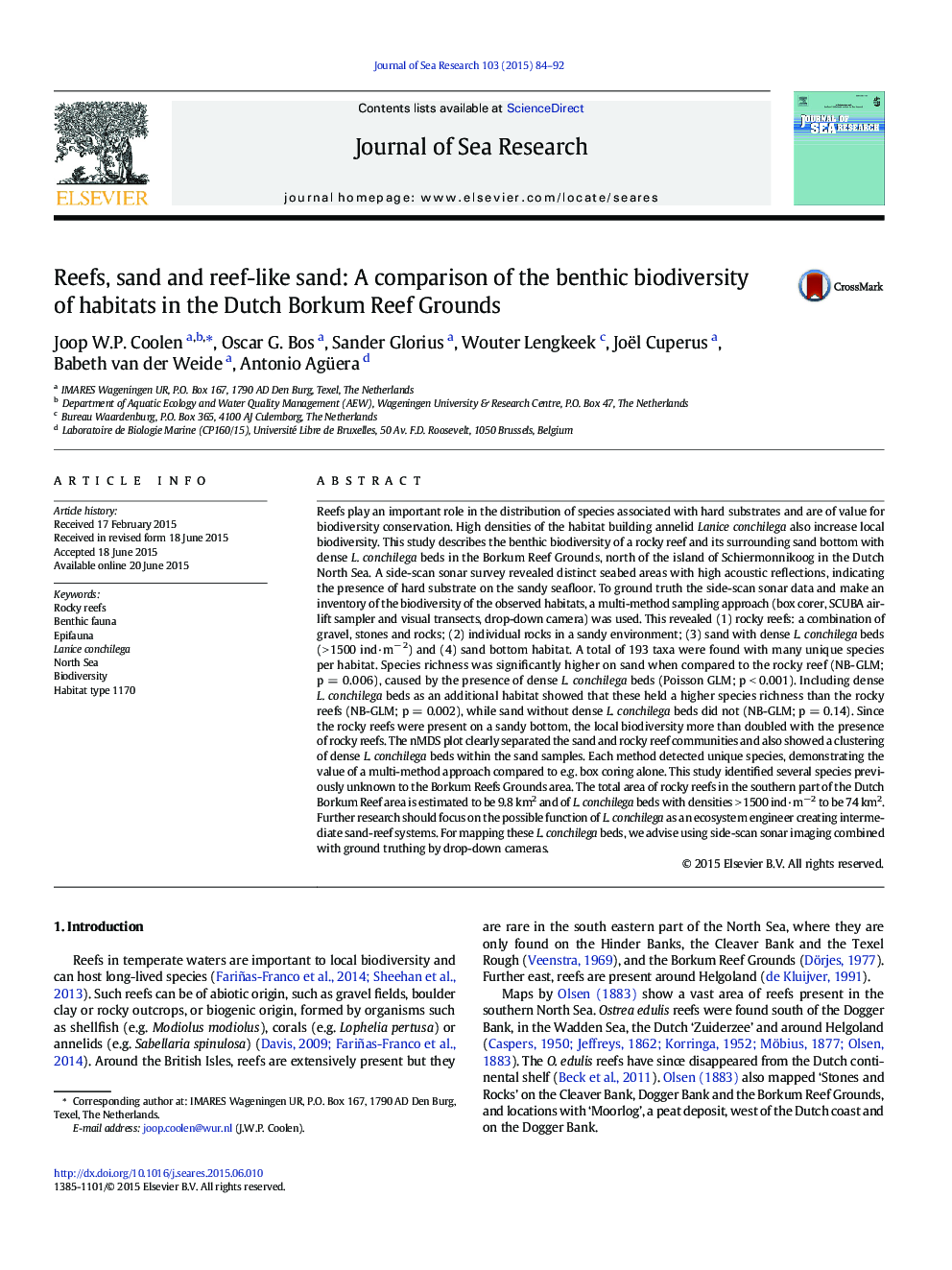| کد مقاله | کد نشریه | سال انتشار | مقاله انگلیسی | نسخه تمام متن |
|---|---|---|---|---|
| 6387292 | 1627471 | 2015 | 9 صفحه PDF | دانلود رایگان |

- With a combination of methods we inventoried natural reefs in the Dutch North Sea.
- Of 193 taxa in total, 137 were found on the reefs and 120 in the surrounding sand.
- Lanice conchilega is an ecosystem engineer creating intermediate sand-reef systems.
- For mapping these L. conchilega beds, we advise to use side-scan sonar imaging.
- The reefs were present on a sandy bottom, doubling the local biodiversity.
Reefs play an important role in the distribution of species associated with hard substrates and are of value for biodiversity conservation. High densities of the habitat building annelid Lanice conchilega also increase local biodiversity. This study describes the benthic biodiversity of a rocky reef and its surrounding sand bottom with dense L. conchilega beds in the Borkum Reef Grounds, north of the island of Schiermonnikoog in the Dutch North Sea. A side-scan sonar survey revealed distinct seabed areas with high acoustic reflections, indicating the presence of hard substrate on the sandy seafloor. To ground truth the side-scan sonar data and make an inventory of the biodiversity of the observed habitats, a multi-method sampling approach (box corer, SCUBA airlift sampler and visual transects, drop-down camera) was used. This revealed (1) rocky reefs: a combination of gravel, stones and rocks; (2) individual rocks in a sandy environment; (3) sand with dense L. conchilega beds (> 1500 ind·mâ 2) and (4) sand bottom habitat. A total of 193 taxa were found with many unique species per habitat. Species richness was significantly higher on sand when compared to the rocky reef (NB-GLM; p = 0.006), caused by the presence of dense L. conchilega beds (Poisson GLM; p < 0.001). Including dense L. conchilega beds as an additional habitat showed that these held a higher species richness than the rocky reefs (NB-GLM; p = 0.002), while sand without dense L. conchilega beds did not (NB-GLM; p = 0.14). Since the rocky reefs were present on a sandy bottom, the local biodiversity more than doubled with the presence of rocky reefs. The nMDS plot clearly separated the sand and rocky reef communities and also showed a clustering of dense L. conchilega beds within the sand samples. Each method detected unique species, demonstrating the value of a multi-method approach compared to e.g. box coring alone. This study identified several species previously unknown to the Borkum Reefs Grounds area. The total area of rocky reefs in the southern part of the Dutch Borkum Reef area is estimated to be 9.8 km2 and of L. conchilega beds with densities > 1500 ind·mâ 2 to be 74 km2. Further research should focus on the possible function of L. conchilega as an ecosystem engineer creating intermediate sand-reef systems. For mapping these L. conchilega beds, we advise using side-scan sonar imaging combined with ground truthing by drop-down cameras.
Journal: Journal of Sea Research - Volume 103, September 2015, Pages 84-92